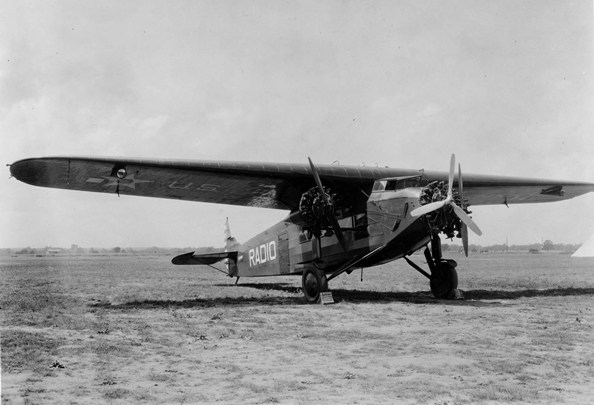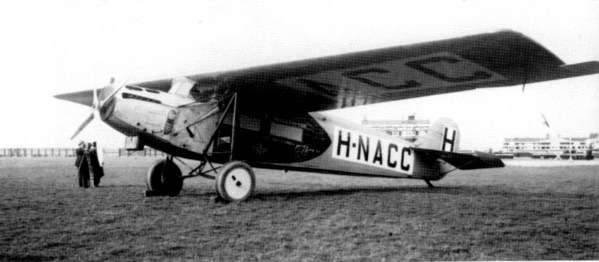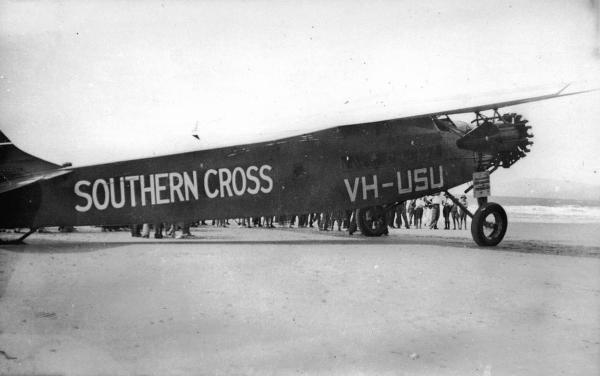
|
 |
Fokker F.VII |
 |
 |
 |
 |
 |
|---|---|---|---|---|---|---|---|
 |
 |
 |
 |
 |
|||
 |
||
|
The Fokker F.VII was a successful 1920s tri-motor airliner that was operated by many counties throughout Europe as well as in Africa, the Middle East, Asia, Australia and the United States. It also participated in several famous flights for such notables as Kingsford Smith, Amelia Earhart and Admiral Byrd. It could carry eight to twelve passengers plus a two-man crew. Construction consisted of steel tubing, fabric covering and laminated-wood covered wings. It was able to use a variety of engines that included the Wright Whirlwind, Gnome-Rhone Titan and Armstrong-Siddeley Lynx. More than 250 aircraft were produced and it made its inaugural flight on November 24, 1924.1

The original F.VII was designed as a single-engine airplane. The original F.VII was a single-engine airplane powered by either a 260 hp Rolls Royce Eagle IX, 450 hp Napier Lion or Bristol Jupiter engine. In 1925, the F.VIIa was powered by a 400 hp Packard Liberty engine and was demonstrated in the United States. While promoting his aircraft the United States, Anthony Fokker participated in the Ford Reliability Tour and produced a version with three 200 hp Wright J-4 Whirlwind engines. This was the first Fokker tri-motor and it made its inaugural flight on September 4, 1925. The airplane easily won the contest and approximately sixty-three F.VIIas and tri-motor F.VIIa-3ms were constructed. Eighteen airplanes were exported to the United States. Henry Ford took notice of the Fokker aircraft and this led to the development of the Ford Trimotor. |
| The F.VIIb-3m was a slightly larger version with a longer wingspan and flew with at least a dozen different engine types. It was the most widely built model and approximately 145 of this variation were constructed. Variants also included the F.VIIb-3m/M bomber and F.VIIb-3m/W seaplane.2 |
|
From 1928 to 1929, the F-10 and F-10A version appeared. It was designed to meet the requirements of Western Air Express and was powered by either three 420 hp or 450 hp Pratt & Whitney Wasp engines. The F-10 wings were constructed in the Netherlands, while the F-10A wings were American made with improved performance and a slightly larger wingspan. Approximately sixty F-10As were built.
There were several notable flights for the F.VII. On May 9, 1926, Richard E. Byrd claimed to have flown over the North Pole in the Fokker F.VIIa/3m Josephine Ford, a few days before Roald Amundsen accomplished the feat in the airship Norge. In June 1928, Sir Charles Kingsford Smith piloted the first aircraft to cross the Pacific from the United States to Australia and the first to cross the Tasman Sea, flying from Australia to New Zealand. He returned in September that year flying a F.VIIb/3m, christened the Southern Cross. And on June 17, 1928, Amelia Earhart became the first woman to fly across the Atlantic as a passenger aboard the Fokker F.VIIb/3m Friendship.

Charles Kingsford Smith made many epic flights in his F.VIIb/3m, the Southern Cross. |
| Specifications: | |
|---|---|
| Fokker F.VIIb/3m | |
| Dimensions: | |
| Wing span: | 71 ft 2 in (21.70 m) |
| Length: | 47 ft 11 in (14.60 m) |
| Height: | 12 ft 8 in (3.90 m) |
| Weights: | |
| Empty: | 6,725 lb (3,050 kg) |
| Gross T/O: | 11,570 lb (5,200 kg) |
| Performance: | |
| Cruise Speed: | 106 mph (170 km/h) |
| Powerplant: | |
| Three 220 hp (164 kW) Wright J-5 Whirwind, 9 cylinder engines. | |
Endnotes:
|
1. Kenneth Munson. Airliners Between the Wars 1919-39. New York: The Macmillan Company, 1972. 141. 2. Enzo Angelucci and Paolo Matricardi. World Aircraft 1918-1935. New York: Rand McNally & Company, 1976. 203. |
©Larry Dwyer. The Aviation History On-Line Museum.
All rights reserved.
Created October 3, 2013.